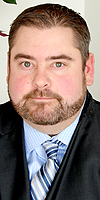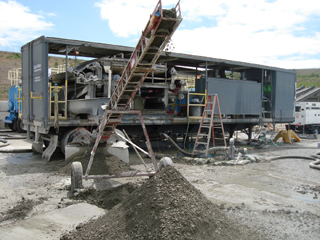|
Subscribe / Renew |
|
|
Contact Us |
|
| ► Subscribe to our Free Weekly Newsletter | |
| home | Welcome, sign in or click here to subscribe. | login |
Construction
| |
 |
November 20, 2008
Clean water a priority for runway project
Clear Water Compliance Services

Ziemer
|
Anyone who has flown out of Seattle-Tacoma International Airport in recent years has undoubtedly noticed that the Port of Seattle has been busy with construction.
The largest portion of construction, Sea-Tac’s new third runway, was recently completed after more than a decade of planning, permitting and on-the-ground activity. Environmental protection was the biggest concern during the planning phase and one of the most significant accomplishments of the finished project.
High on the list of concerns was protecting the water quality of surrounding creeks and wetlands from the potentially damaging effects of construction stormwater runoff. The port worked with their engineers, contractors and consultants to ensure these issues were addressed with the latest techniques.
Concerns over the protection of endangered salmon within Miller and Des Moines creeks arose early during the project’s permitting phase.
The chief concerns were related to sediment and other pollutants such as metals and nutrients that are commonly associated with construction stormwater runoff. These were significant issues considering that construction activities would proceed during the wet Northwest winters, include 375 acres of land disturbance and involve movement of more than 16 million cubic yards of soil.
Limiting runoff
In order to protect water quality, the Washington State Department of Ecology issued a National Pollutant Discharge Elimination System permit to the port to limit potential impacts from construction stormwater runoff. The permit required a 5 nepholometric turbidity unit discharge limit, a level typically 10 to 100 times less than uncontrolled construction stormwater runoff. (NTU is a measure of water clarity.)
Failing to prevent sediment-laden stormwater from entering nearby streams can have a tremendous impact on aquatic resources such as fish because the stormwater can smother spawned eggs. It can also lower visibility, which decreases feeding capability and even raises water temperature because the sediments absorb ultraviolet radiation.
Controlling erosion, sediments
The port worked proactively to comply with the stormwater permit, and evaluated multiple approaches to meet the stringent requirements. Managing the environmental components of the project proved challenging and required using innovative techniques to control on-site water issues and prevent off-site impacts.
The port implemented an integrated approach to erosion and sediment control and stormwater management.
Their strategy included mandatory erosion- and sediment-control training for contractors. Training project personnel was a first line of defense against off-site pollution. Contractors used the training to implement construction best management practices, or BMPs — methods designed to prevent, reduce and eliminate stormwater impacts associated with the erosion of sediment.
The port conducted independent erosion- and sediment-control inspections to ensure that contractors were properly installing, monitoring and maintaining BMPs. Since following conventional BMPs alone would not have been sufficient to meet state water-quality standards, the port required the use of chemical stormwater treatment BMPs, which are more effective at reducing sediment and other associated pollutants.
Recycled crab shells
The port coupled conventional erosion-control practices with an emerging water-purification technology called chitosan-enhanced sand filtration. The process involves adding a treatment agent called chitosan, which is made from recycled crab shells, to turbid stormwater as it is pumped through an industrial sand filter.
The port selected this process because it was the only technology available that could meet their specifications of producing 6,000 gallons per minute of treatment with a continuous effluent turbidity of less than 5 NTU, the level required by the permit (similar to levels found in area streams).
The stormwater-treatment process purified more than half a billion gallons of turbid stormwater, enough to fill more than 750 Olympic-sized swimming pools. The purified stormwater that was discharged to Miller and Des Moines creeks was as clean or cleaner than the stream water.
Runway gets its grooves
As a final step in the runway construction, the concrete surface of the runway was grooved to a depth of one-fourth of an inch.
The purpose of the grooving is to eliminate hydroplaning on wet runways. Grooving reduces the pavement’s drying time, which improves skid resistance, shortening the braking distances of aircraft on wet pavement.
The grooves were installed by a large motorized grinding machine that used water to cool the grinding bits and prevent airborne dust. This process created a concrete mud, similar in consistency to a thin milk shake, which contained cooling water and ground concrete particles.
This slurry was collected in tanker trucks and hauled to the on-site dewatering press, which separated the slurry into clarified water and a damp, soil-like material.
The clarified water was reused as cooling water for the grinding operation, and eventually discharged to the sanitary sewer. The soil-like material was conveyed to a standard dump truck.
The runway grooving project generated more than 575,000 gallons of concrete slurry. The slurry’s high alkalinity (with a pH of 12.5) would have marked it as a hazardous waste for disposal. After being treated with carbon dioxide, the soil-like material had a neutral pH and was disposed as non-hazardous material.
The dewatering process provided the equivalent of nearly 500,000 gallons of cooling water by continually recycling clarified water to the grooving site. Approximately 100,000 gallons of clarified water were discharged during the project, all below the 10.5 pH discharge required for sanitary sewer disposal.
This process provided tremendous cost savings by minimizing water fees, and by reducing waste hauling and disposal charges of the slurry waste material.
Detention pond maintenance
The mobile belt press system was also applied to the stormwater detention facilities for the runway.
After seasons of sediment buildup, the ponds needed to be cleaned out to retain capacity for future storms. Cleaning out the wet sludge material at the bottom of the ponds is always very labor-intensive and costly to accomplish. By putting a mobile sludge-management technology to use, maintenance on the stormwater detention facilities was simplified.
The erosion and sediment control and stormwater management during the construction projects at Sea-Tac have been models for other infrastructure projects throughout the nation.
These projects saw some of the worst winter storm events in Northwest history. Yet through the use of chitosan-enhanced sand filtration technology and the cooperation of all the parties involved, the project remained in compliance with its permits, and construction was able to continue without delays from water-quality violations or shutdowns.
By employing innovative techniques and finding cost-saving alternatives, the port could maintain a high compliance standard and still achieve their project goals.
Jason Ziemer is an environmental scientist and a principal of Clear Water Compliance Services. Ziemer has spent the last decade working with contractors, developers and regulatory agencies to address erosion/sediment control and stormwater management issues.
Other Stories:



